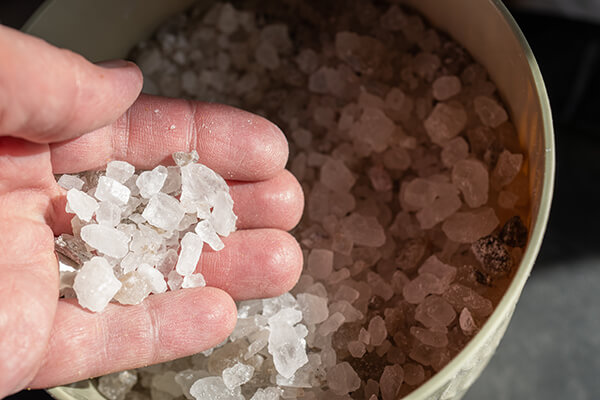Tips for driveway salting for less environmental impact
Did you know that the United States uses an estimated 20 million metric tons of salt on roads every year? In places like the Lake Champlain basin the long, cold winters mean a lot of salt applied on our roads and sidewalks, but all of that salt can pollute our soils and waters and harm local ecosystems.
“Road salt can make its way via streams to local lakes and ponds,” explains Lake Champlain Sea Grant Associate Director Kris Stepenuck. “Once there, it will only accumulate and can cause unsafe — or even toxic — conditions for fish and other aquatic life.”
Want to know what you can do to protect your nearby forests and waterways? Follow these easy guidelines:
• Check to see if the conditions are right.
Salt depresses the freezing point of water, which makes it effective at reducing ice formation and accumulation on streets and sidewalks in the winter — down to a certain temperature. Sodium chloride, the most common type of road salt, is not effective when the pavement temperature is colder than around 16F (-9C). So be sure to check the temperature of the pavement with an infrared thermometer before you salt. If it’s too cold, opt for an alternative such as gravel, sand or even cat litter. These materials will provide extra traction to help prevent slipping. These materials will also absorb more heat from sunlight which helps melt the snow.

Don’t have a paved driveway? If your driveway is gravel or dirt, applying salt is even more harmful for the environment and can cause dangerous conditions for driving, and experts don’t recommend using salt at all. Instead, try salt alternatives like gravel, sand, or cat litter to increase traction.
• Salt before the snow
You just checked the forecast to see if it’s the right temperature to apply salt and saw a big storm rolling in. What can you do? If you salt before the storm, it provides a buffer between your driveway and the snow which makes shoveling easier and driving safer.
Bonus points if you dissolve the salt in water first and spray the mixture on your driveway. “Using a 23 percent salt-water solution acts like butter in a frying pan,” says Stepenuck. “This reduces the ability of snow and ice to bond with the surface. Using a salt-water mixture can reduce total salt use and make it easier to plow or shovel after the storm. Plus, since any dry salt you spread must combine with water to minimize ice formation, the mixture can work its magic more quickly than if you spread dry salt.” Learn how to make a salt-water solution.
• Shovel, then salt.
If you apply salt to your driveway when it already has a layer of snow on it, the salt will need to seep through the layer of snow before it can start working, meaning you would need more salt to keep the driveway free from snow and ice. Instead, shovel first and apply the salt as close to the pavement as you can.
• Use the right amount.
Salt is often spread on driveways and sidewalks without much rhyme or reason, but the amount of salt you use matters. A good rule of thumb is to spread no more than a cup or a cup and a half of rock salt for every 10 sidewalk squares or every two parking spaces. There should be about 3 inches between each of the salt grains. Using more than that doesn’t make it more effective, it just allows more salt to runoff into the environment, to be tracked into the house or to damage doors, steps or other structures, and wastes money.
If you used too much salt and see it on your driveway or walkways after the snow is gone, sweep it up. You can save it and use it for the next storm. Otherwise, this excess salt will slowly infiltrate into the soil around it or runoff your driveway ultimately polluting a nearby waterway.
• Tell your neighbors.
The best way to increase your impact is to get other people on board. Share these tips with your friends and neighbors so that we can all have a safe and sustainable winter.
To learn more about what you can do to become salt savvy and to help reduce salt use in the Lake Champlain basin, check out the Lake Champlain Sea Grant road salt and water quality page.
If you have any questions, please email the Lake Champlain Sea Grant.
(Anna Marchessault is program assistant with the Lake Champlain Sea Grant Institute which is a cooperative effort of the Rubenstein School of Environment and Natural Resources at the University of Vermont and the Lake Champlain Research Institute at the State University of New York College at Plattsburgh.)

